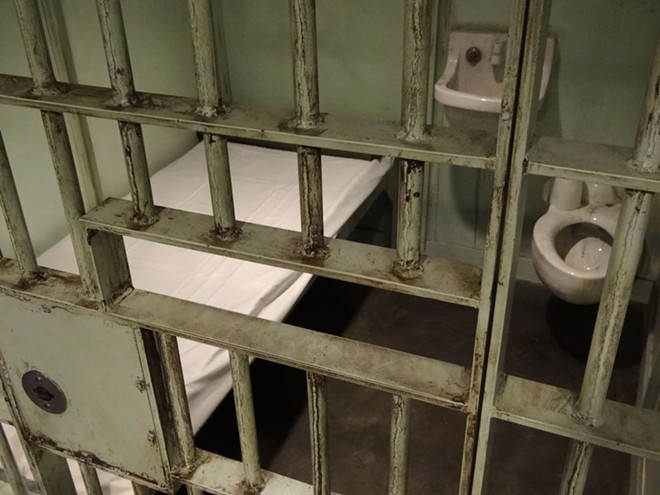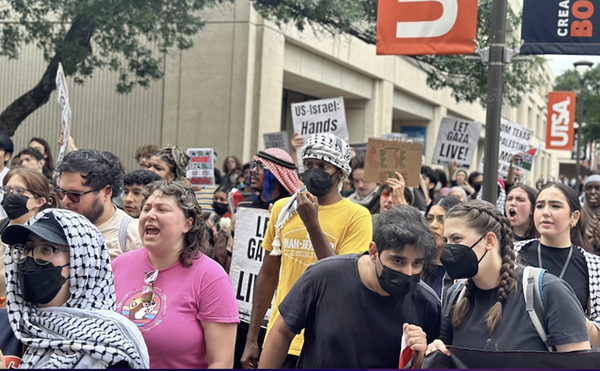
The letter made the incarcerated men’s intentions clear. Decrying decades of “lies of improved conditions, abuse of power, deprivations of our senses, inhumane treatment and conditions,” they called on state leaders to dramatically alter the prison system’s solitary confinement practices. If not, they vowed to “escalate efforts.”
Their words, typed up in small font and sent out in October, were ignored for months, and the promised escalation came: Hundreds of people in Texas prisons began a hunger strike campaign on Jan. 10, the first day of the 88th legislative session. The strike mainly targets solitary confinement practices—during which men and women can be indefinitely kept in individual cells for at least 22 hours a day, allowed out only to bathe or exercise in other cages.
Their plea proposed improvements, including eliminating solitary in cases of suspected gang affiliation, capping the time someone can spend in administrative segregation, and giving those in administrative segregation access to rehabilitative programs and housing in climate-controlled facilities.
“The proposals that have been put forth by the people in restricted housing are reasonable. They make sense,” said Michele Deitch, director of the University of Texas Prison and Jail Innovation Lab. “These are workable proposals, and they’re sensible, and definitely something that’s worth taking a look at.”
Strikers were organized inside and outside of Texas Department of Criminal Justice’s (TDCJ) walls. Fourteen units signed on to participate, but they didn’t begin all at once. Instead, they’re taking shifts. When one batch of units stops, another will take over. Organizers say the plan remains in motion, despite reports that the hunger strike was winding down. Per TDCJ policy, prison officials monitor the men participating in the hunger strike. No women are currently involved, according to a TDCJ spokesperson.
These strikers have the benefit of a road map. A similar strike actually yielded results in California almost a decade ago. There, prisoners embarked on a two-month hunger strike, which ultimately led to a federal court settlement that eliminated indefinite solitary confinement as well as the practice of placing people in solitary only for suspected gang affiliation.
The Texas organizers deliberately widened their scope, according to Brittany Robertson, an outside activist involved in the action. “They wanted to make sure … if there were any changes, it wouldn’t be unit by unit, but it would be the statewide system that would change,” Robertson said. “The phrase that was used by a few of them is, ‘I’m willing to die for the cause, because I can’t live.’”
It’s impossible to tell whether the current action will yield results. Outside organizers say the men inside have gotten verbal promises from prison staff that things will improve. But prison strikes are notoriously difficult to track, as information between prisoners, outside organizers and media gets stifled. One prisoner housed at the Wainwright Unit in Houston wrote organizers to report that men participating in the strike weren’t being properly counted. Per prison policy, they have to refuse meals for 72 hours before they’re considered on strike.
“Our main goal is to end Ad-Seg/RH [administrative segregation/restricted housing] but this hunger strike is aimed to address and fix the immediate issues here on this unit that are not only reasonable but also very fixable,” the Wainwright prisoner wrote. “We are tired. Tired of the complacency of this administration that we have voiced all this to, to only fall on deaf ears starting with the line CO’s all the way up.”
Hunger strikes remain one of the primary ways people can call attention to conditions inside prisons, short of a federal lawsuit (which, after 1990s legislation, became much more difficult).
Robert Perkinson, author of Texas Tough: The Rise of America’s Prison Empire, said multiple factors can lead prisoners to engage in what we might call extreme methods of protest. Intensive dehumanization, a lack of redress within the system, and a dearth of interest from people outside prison walls. “They have no legal rights, total dehumanization, they’re in completely hierarchical institutions, and nobody cares. It’s those kinds of conditions that lead people to throw feces and urine, to hunger strike, to injure themselves—or to commit suicide,” Perkinson said.
Texas prisons have reached this boiling point before, though few strikes have brought results.
In Fall of 2006, a dozen men on Texas’ death row launched a hunger strike in response to conditions at the Polunsky Unit in Livingston. Prison administration had tightened its grip around conditions after Martin Gurule’s infamous 1998 escape from death row, then housed in Huntsville at the Ellis Unit. During the month-long hunger strike, a man on Texas’ death row—Michael Johnson—died by suicide after writing a proclamation of innocence in his own blood.
In 2016, the United States experienced what was believed to be the biggest prison strike in national history, involving as many as 50 prisons and 24,000 participants. This effort—which involved mostly work stoppages, although some went on hunger strikes—was in protest of prisons’ exploitative labor practices. The timing was apt: It launched in September 2016, on the 45th anniversary of the Attica Correctional Facility uprising, among the deadliest prison riots.
In Texas, where prisoners aren’t paid for their labor, prison officials denied that the residents of any of its units were participating, but Vox reported multiple Texas prisons had gone on lockdown due to the strike. Outside of prisons, demonstrations spread across the country, including in Austin.
Just a year after the national strike ended, 45 men in administrative segregation at a North Texas prison — where 15% of the entire prison system’s administrative segregation population was housed at that time — went on a hunger strike in December 2017. They wanted the prison administration to address extreme temperatures, food quality, and recreation time. The strike appeared to fizzle out with no real redress for the prisoners’ grievances.
TDCJ policy supposedly no longer allows administrative segregation to be used as a punishment for infractions—they did away with that in 2017, months before the December strike. But there’s a huge loophole: People can still be put into administrative segregation after an infraction if it’s to prevent future harm. Other highly subjective reasons can land people in the dangerous monotony of solitary: being labeled an escape risk or a “confirmed” member of a prison gang.
“Those kinds of distinctions typically matter more on paper than they do in practice within the institution, and they matter even less from the perspective of the person subjected to solitary confinement,” Perkinson said.
In Texas, many people are still put in solitary confinement indefinitely, despite a growing body of evidence that says solitary confinement can cause irreparable damage, as the Texas Observer has reported.
Hunger strikes in particular remain a crucial tool for prisoners in administrative segregation. They don’t hold jobs, so work stoppages are out of the question. They aren’t permitted to communicate with other prisoners regularly, so group actions like sit-ins become untenable. All they have left is the deeply personal act of refusing to eat.
Deitch, the expert from the University of Texas, said hunger strikes tend to be favored by people in solitary confinement for a simple reason. “That’s because they have nothing else. These are people who live in such deprived environments, such punitive, harsh settings, that they don’t have privileges, they don’t have access to a lot of a lot of things. So giving up food is literally about the only thing they can give up. And that’s why it’s such a powerful statement about their belief and whatever their cause is.”
The legislature may already be listening. At least one state legislator is hoping to address the state’s draconian policy in this year’s legislative session. Representative Terry Meza has filed two related bills: one that would cap the number of consecutive days a person can spend in solitary confinement and another that would mandate a one-time study on the effect of TDCJ’s administrative segregation policies.
“In the event there is more than one inmate on a hunger-strike, the inmates can be separated,” reads the department’s policy on managing hunger strikes. “Sensationalism of the hunger strike should be avoided.”
Coming soon: SA Current Daily newsletter. We’ll send you a handful of interesting San Antonio stories every morning. Subscribe now to not miss a thing.Follow us: Google News | NewsBreak | Instagram | Facebook | Twitter
















